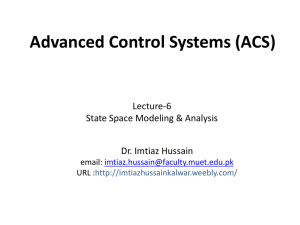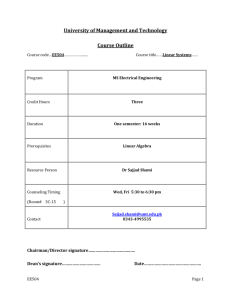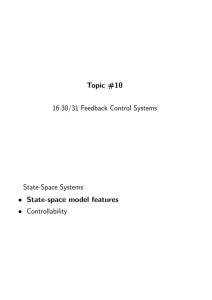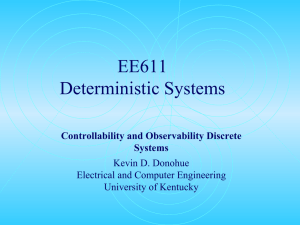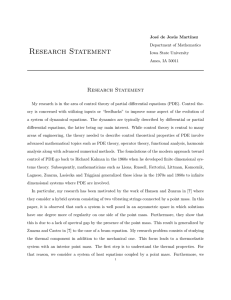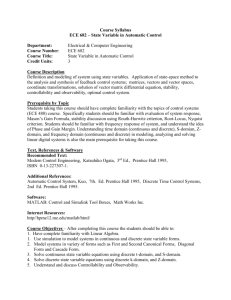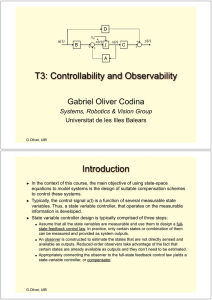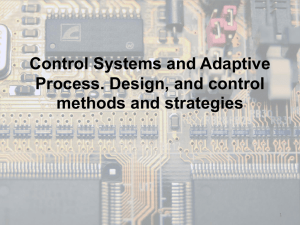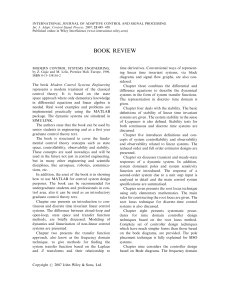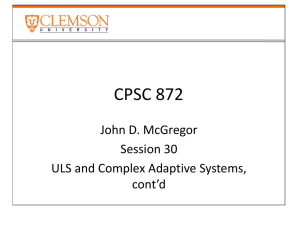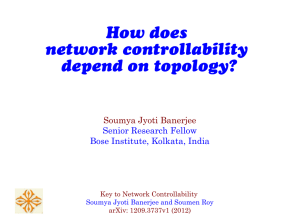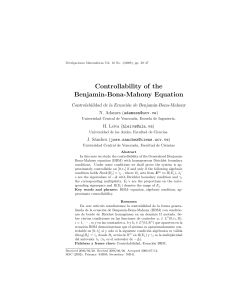Feedback Control Systems (FCS) - Dr. Imtiaz Hussain
advertisement
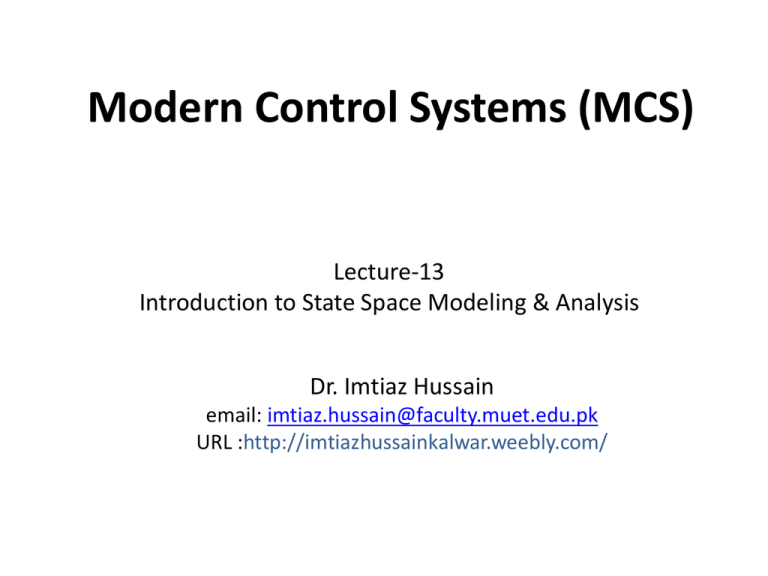
Modern Control Systems (MCS) Lecture-13 Introduction to State Space Modeling & Analysis Dr. Imtiaz Hussain email: imtiaz.hussain@faculty.muet.edu.pk URL :http://imtiazhussainkalwar.weebly.com/ Lecture Outline • Introduction to state space – Basic Definitions – State Equations – State Diagram – State Controllability – State Observability – Output Controllability Introduction • Modern control theory is contrasted with conventional control theory in that the former is applicable to multiple-input, multiple-output systems, which may be linear or nonlinear, time invariant or time varying, while the latter is applicable only to linear time invariant singleinput, single-output systems. Definitions • State of a system: We define the state of a system at time t0 as the amount of information that must be provided at time t0, which, together with the input signal u(t) for t t0, uniquely determine the output of the system for all t t0. • State Variable: The state variables of a dynamic system are the smallest set of variables that determine the state of the dynamic system. • State Vector: If n variables are needed to completely describe the behaviour of the dynamic system then n variables can be considered as n components of a vector x, such a vector is called state vector. • State Space: The state space is defined as the n-dimensional space in which the components of the state vector represents its coordinate axes. Definitions • Let x1 and x2 are two states variables that define the state of the system completely . dx dt x2 State (t=t1) Velocity State (t=t1) State Vector x1 Two Dimensional State space x Position State space of a Vehicle 5 State Space Equations • In state-space analysis we are concerned with three types of variables that are involved in the modeling of dynamic systems: input variables, output variables, and state variables. • The dynamic system must involve elements that memorize the values of the input for t> t1 . • Since integrators in a continuous-time control system serve as memory devices, the outputs of such integrators can be considered as the variables that define the internal state of the dynamic system. • Thus the outputs of integrators serve as state variables. • The number of state variables to completely define the dynamics of the system is equal to the number of integrators involved in the system. State Space Equations • Assume that a multiple-input, multiple-output system involves 𝑛 integrators. • Assume also that there are 𝑟 inputs 𝑢1 𝑡 , 𝑢2 𝑡 , ⋯ , 𝑢𝑟 𝑡 and 𝑚 outputs 𝑦1 𝑡 , 𝑦2 𝑡 , ⋯ , 𝑦𝑚 𝑡 . • Define 𝑛 outputs of the integrators as state variables: 𝑥1 𝑡 , 𝑥2 𝑡 , ⋯ , 𝑥𝑛 𝑡 . • Then the system may be described by 𝑥1 𝑡 = 𝑓1 (𝑥1 , 𝑥2 , ⋯ , 𝑥𝑛 ; 𝑢1 , 𝑢2 , ⋯ , 𝑢𝑟 ; 𝑡) 𝑥2 𝑡 = 𝑓2 (𝑥1 , 𝑥2 , ⋯ , 𝑥𝑛 ; 𝑢1 , 𝑢2 , ⋯ , 𝑢𝑟 ; 𝑡) 𝑥𝑛 𝑡 = 𝑓𝑛 (𝑥1 , 𝑥2 , ⋯ , 𝑥𝑛 ; 𝑢1 , 𝑢2 , ⋯ , 𝑢𝑟 ; 𝑡) State Space Equations • The outputs 𝑦1 𝑡 , 𝑦2 𝑡 , ⋯ , 𝑦𝑚 𝑡 of the system may be given as. 𝑦1 𝑡 = 𝑔1 (𝑥1 , 𝑥2 , ⋯ , 𝑥𝑛 ; 𝑢1 , 𝑢2 , ⋯ , 𝑢𝑟 ; 𝑡) 𝑦2 𝑡 = 𝑔2 (𝑥1 , 𝑥2 , ⋯ , 𝑥𝑛 ; 𝑢1 , 𝑢2 , ⋯ , 𝑢𝑟 ; 𝑡) 𝑦𝑚 𝑡 = 𝑔𝑚 (𝑥1 , 𝑥2 , ⋯ , 𝑥𝑛 ; 𝑢1 , 𝑢2 , ⋯ , 𝑢𝑟 ; 𝑡) • If we define 𝑥1 𝑥2 𝒙 𝑡 = ⋮ 𝑥𝑛 𝑓1 (𝑥1 , 𝑥2 , ⋯ , 𝑥𝑛 ; 𝑢1 , 𝑢2 , ⋯ , 𝑢𝑟 ; 𝑡) 𝑓 (𝑥 , 𝑥 , ⋯ , 𝑥𝑛 ; 𝑢1 , 𝑢2 , ⋯ , 𝑢𝑟 ; 𝑡) 𝒇 𝒙, 𝒖, 𝑡 = 2 1 2 ⋮ 𝑓𝑛 (𝑥1 , 𝑥2 , ⋯ , 𝑥𝑛 ; 𝑢1 , 𝑢2 , ⋯ , 𝑢𝑟 ; 𝑡) 𝑦1 𝑦2 𝒚 𝑡 = ⋮ 𝑦𝑚 𝑔1 (𝑥1 , 𝑥2 , ⋯ , 𝑥𝑛 ; 𝑢1 , 𝑢2 , ⋯ , 𝑢𝑟 ; 𝑡) 𝑔2 (𝑥1 , 𝑥2 , ⋯ , 𝑥𝑛 ; 𝑢1 , 𝑢2 , ⋯ , 𝑢𝑟 ; 𝑡) 𝒈 𝒙, 𝒖, 𝑡 = ⋮ 𝑔𝑚 (𝑥1 , 𝑥2 , ⋯ , 𝑥𝑛 ; 𝑢1 , 𝑢2 , ⋯ , 𝑢𝑟 ; 𝑡) 𝑢1 𝑢2 𝒖 𝑡 = ⋮ 𝑢𝑟 State Space Modelling • State space equations can then be written as 𝒙 𝑡 = 𝒇(𝒙, 𝒖, 𝑡) 𝒚 𝑡 = 𝒈(𝒙, 𝒖, 𝑡) State Equation Output Equation • If vector functions f and/or g involve time t explicitly, then the system is called a time varying system. State Space Modelling • If above equations are linearised about the operating state, then we have the following linearised state equation and output equation: x (t ) A(t ) x(t ) B(t )u (t ) y (t ) C (t ) x(t ) D(t )u (t ) State Space Modelling • If vector functions f and g do not involve time t explicitly then the system is called a time-invariant system. • In this case, state and output equations can be simplified to x (t ) Ax(t ) Bu (t ) y (t ) Cx(t ) Du (t ) D C B A Example-1 • Consider the mechanical system shown in figure. We assume that the system is linear. The external force u(t) is the input to the system, and the displacement y(t) of the mass is the output. The displacement y(t) is measured from the equilibrium position in the absence of the external force. This system is a single-input, singleoutput system. • From the diagram, the system equation is 𝑚𝑦(𝑡) + 𝑏𝑦(𝑡) + 𝑘𝑦(𝑡) = 𝑢(𝑡) • This system is of second order. This means that the system involves two integrators. Let us define state variables 𝑥1 (𝑡) and 𝑥2 (𝑡) as 𝑥1 𝑡 = 𝑦(𝑡) 𝑥2 𝑡 = 𝑦(𝑡) Example-1 𝑥1 𝑡 = 𝑦(𝑡) 𝑥2 𝑡 = 𝑦(𝑡) 𝑚𝑦(𝑡) + 𝑏𝑦(𝑡) + 𝑘𝑦(𝑡) = 𝑢(𝑡) • Then we obtain 𝑥1 𝑡 = 𝑥2 (𝑡) • Or 𝑏 𝑘 1 𝑥2 𝑡 = − 𝑦 𝑡 − 𝑦 𝑡 + 𝑢 (𝑡) 𝑚 𝑚 𝑚 𝑥1 𝑡 = 𝑥2 (𝑡) 𝑏 𝑘 1 𝑥2 𝑡 = − 𝑥2 𝑡 − 𝑥1 𝑡 + 𝑢 (𝑡) 𝑚 𝑚 𝑚 • The output equation is 𝑦 𝑡 = 𝑥1 𝑡 Example-1 𝑥1 𝑡 = 𝑥2 (𝑡) 𝑏 𝑘 1 𝑥2 𝑡 = − 𝑥2 𝑡 − 𝑥1 𝑡 + 𝑢 (𝑡) 𝑚 𝑚 𝑚 𝑦 𝑡 = 𝑥1 𝑡 • In a vector-matrix form, x1 (t ) 0 x (t ) k 2 m y (t ) 1 1 x (t ) 0 b 1 1 u (t ) x2 (t ) m m x1 (t ) 0 x ( t ) 2 Example-1 • State diagram of the system is 𝑥1 𝑡 = 𝑥2 (𝑡) 𝑏 𝑘 1 𝑥2 𝑡 = − 𝑥2 𝑡 − 𝑥1 𝑡 + 𝑢 (𝑡) 𝑚 𝑚 𝑚 𝑦 𝑡 = 𝑥1 𝑡 -k/m -b/m 𝑢(𝑡) 1/m 𝑥2 1/s 𝑥2 = 𝑥1 1/s 𝑥1 𝑦(𝑡) Example-1 • State diagram in signal flow and block diagram format -k/m -b/m 𝑢(𝑡) 1/m 𝑥2 1/s 𝑥2 = 𝑥1 1/s 𝑥1 𝑦(𝑡) Example-2 • State space representation of armature Controlled D.C Motor. Ra ea La ia B eb T J • ea is armature voltage (i.e. input) and is output. dia ea Ra ia La eb dt T J B Example-2 T K t ia eb K b J B-K t ia 0 dia La Ra ia K b ea dt • Choosing 𝜃, 𝜃 𝑎𝑛𝑑 𝑖𝑎 as state variables 0 1 𝐵 𝜃 0 − 𝑑 𝐽 𝜃 = 𝑑𝑡 𝑖 𝐾𝑏 𝑎 0 − 𝐿𝑎 0 0 𝐾𝑡 𝜃 0 𝐽 𝜃 + 1 𝑒𝑎 𝑅𝑎 𝑖𝑎 𝐿𝑎 − 𝐿𝑎 • Since 𝜃 is output of the system therefore output equation is given as 𝑦 𝑡 = 1 0 𝜃 0 𝜃 𝑖𝑎 State Controllability • A system is completely controllable if there exists an unconstrained control u(t) that can transfer any initial state x(to) to any other desired location x(t) in a finite time, to ≤ t ≤ T. uncontrollable controllable State Controllability • Controllability Matrix CM CM B AB A2 B An1B • System is said to be state controllable if rank (CM ) n State Controllability (Example) • Consider the system given below 1 0 1 x x u 0 3 0 y 1 2x • State diagram of the system is U (s ) 1 s -1 x1 1 1 2 3 x2 s -1 Y (s) State Controllability (Example) • Controllability matrix CM is obtained as CM B AB 1 B 0 1 AB 0 • Thus 1 1 CM 0 0 • Since 𝑟𝑎𝑛𝑘(𝐶𝑀) ≠ 𝑛 therefore system is not completely state controllable. State Observability • A system is completely observable if and only if there exists a finite time T such that the initial state x(0) can be determined from the observation history y(t) given the control u(t), 0≤ t ≤ T. observable unobservable State Observability • Observable Matrix (OM) C CA 2 Observabil ity Matrix OM CA CAn 1 • The system is said to be completely state observable if rank (OM ) n State Observability (Example) • Consider the system given below 0 1 0 x x u 0 2 1 y 0 4x • OM is obtained as • Where C OM CA C 0 4 0 1 CA 0 4 0 12 0 2 State Observability (Example) • Therefore OM is given as 0 4 OM 0 12 • Since 𝑟𝑎𝑛𝑘(𝑂𝑀) ≠ 𝑛 therefore system is not completely state observable. 4 U (s ) 1 s -1 x2 s -1 2 x1 Y (s) Output Controllability • Output controllability describes the ability of an external input to move the output from any initial condition to any final condition in a finite time interval. • Output controllability matrix (OCM) is given as OCM CB CAB CA2 B CAn 1 B Home Work • Check the state controllability, state observability and output controllability of the following system 0 1 0 A , B , C 0 1 1 0 1 To download this lecture visit http://imtiazhussainkalwar.weebly.com/ END OF LECTURES-13
